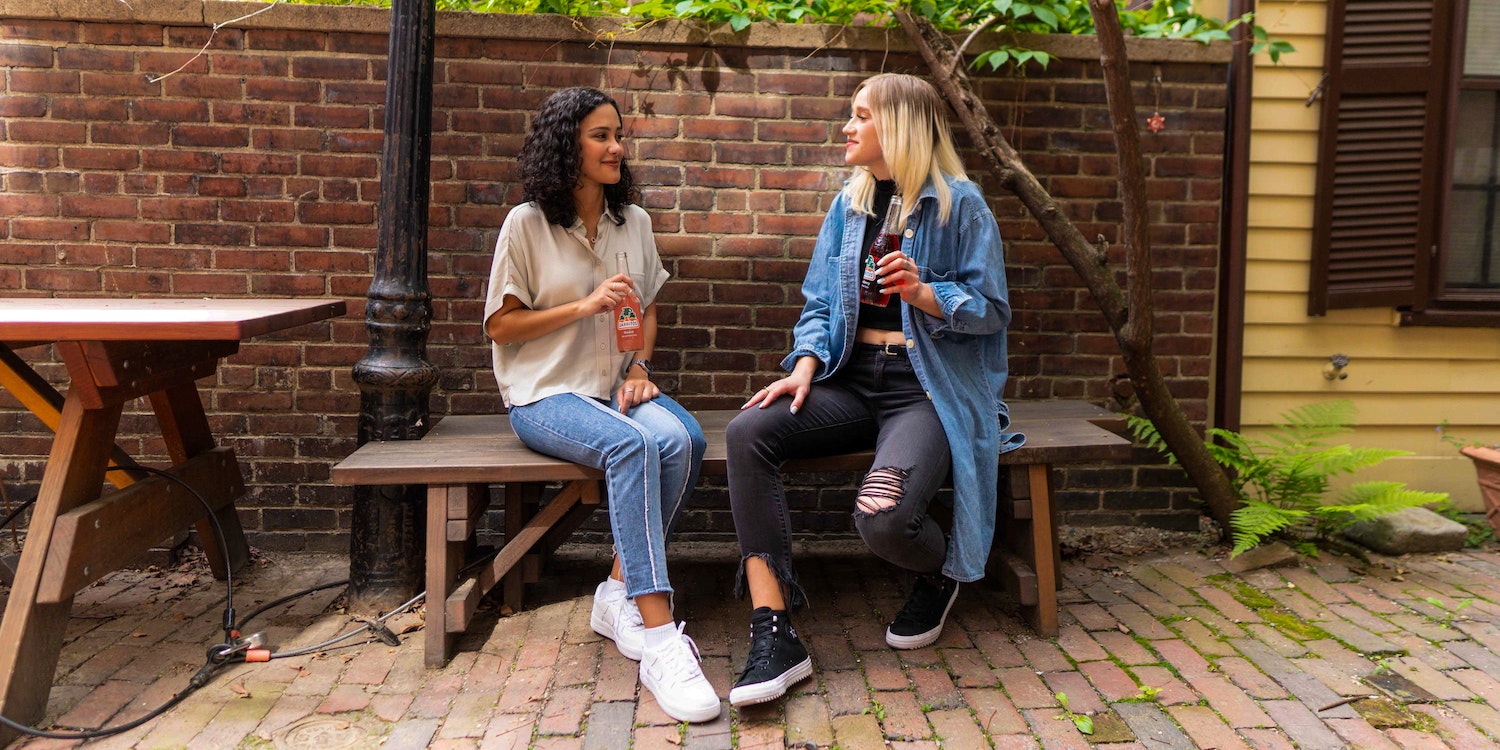Have you ever had someone ask you what your favorite movie is, only to suddenly forget every movie you’ve ever watched?
If so, it’s not just you. Many people find it difficult to answer questions “on the spot.” This can happen with movies, yes — but also when someone asks you about your thoughts on sustainability.
We know this topic matters to you, so we put this guide together to help you feel more confident when talking about sustainability with others. And when you feel comfortable, you can more easily create an open conversation.
So to get started, here are some basic principles to help you navigate conversations about sustainability.
The Basics of Talking About Sustainability
These overarching ideas make it easier to chat about sustainability or zero waste living — or any other topic, for that matter.
You can think of these principles like a toolkit. You may not need all of them in every chat, but you can pull out the ones that are most useful to you.
Keep Things Natural
In casual settings, you can bring up sustainability as a natural part of conversation.
One way to do this is by leading with something you’re doing, such as:
- The other day I read an interesting article about…
- I found this awesome eco-friendly product and..
- I was able to avoid a lot of waste by…
Then you can gauge how open your conversation partner is to chatting more.
Use “I” Statements
This tip is especially useful when you’re talking with someone who doesn’t see sustainability as a priority. “I” statements help avoid making the other person feel pressured or attacked.
Statements that generalize or include “shoulds” may be less helpful. For example, “Everyone should stop buying from Brand A because they hurt the planet by doing X.”
Instead, focus on your own choices and reasoning.
Here are some examples of “I” statements:
- I like using reusables so that I don’t send so much to the landfill.
- Keeping plastic out of the ocean is important to me, so I try to avoid using single-use stuff whenever I can.
- I like shopping with companies that are conscious about the environment.
This brings up another similar tip, which is to share from your own life.
Share Personal Experience
Real-life experiences are a powerful way to form connections. And, like our first tip, it can help make your conversation more comfortable.
You could share what got you started thinking about sustainability, what you’re doing right now, or what you want to try in the future.
Another way to incorporate this is sharing a struggle or worry you overcame. For example: “I thought composting would be super time-consuming, but I’ve actually found a method that’s really easy.”
Give the Right Amount of Detail
When you’re passionate about something, it’s easy to go all in on a discussion. And in some situations, that’s exactly what you should do! If you’re with a fellow sustainability enthusiast, feel free to go down all the rabbit holes.
In casual conversations, it’s often best to keep things light and simple at first. Talking about your motivations or goals is a good place to start. Then if the person you’re talking with seems interested in learning more, you can dig into the deeper topics.
Pay Attention to Your Body Language
Albert Mehrabian, a body language researcher, found that only about 10% of face-to-face communication happens with words. Nonverbal communication makes up the rest, with body language conveying 55% of meaning.
This means that how you use body language has a big impact on your conversation.
You can help foster a more open, friendly conversation by:
- Avoiding crossing your arms or legs
- Turning toward the person you’re talking to
- Sitting or standing next to them instead of across from them (particularly if they’re looking for an argument)
- Having an alert, open posture (not hunched in)
- Nodding and following along with what they say
And using a friendly, calm tone is another way to take advantage of nonverbal communication.
Avoid Getting Defensive
When someone questions or attacks something important to you, you naturally want to defend or justify yourself. However, this can easily lead to conflict.
When you find yourself feeling defensive, try turning the conversation back to things you both agree on. Here are a few phrases you can use to change the subject:
- I think we can both agree on…
- I think we’ll have to agree to disagree on this, and that’s just fine. Let’s talk about…
- This is something that’s important to me, but I totally get that you don’t feel the same way. Why don’t we talk about X instead?
One of the biggest keys here is to try to avoid taking things personally. Try to keep in mind that people’s reactions are often more about themselves and their experiences than they are about you.
Ask Questions In Return
You can engage the other person and have a discussion by asking them questions as well. Helpful questions are often neutral and more open-ended.
For example, you might ask:
- What do you think of when you hear the word “sustainable?”
- Have you ever tried cutting down on plastic waste before?
- What kind of natural settings do you like to visit? Did you ever see litter or vandalism there?
You can also use follow-up questions to clarify others’ opinions or learn more about what they think.
Some questions of this sort include:
- I’m hearing that you want to learn how to X. Is that right?
- What do you mean when you say X?
- I’m not sure I totally understand what you mean. Can you explain?
Understanding is a key to good communication — so don’t be afraid to ask!
Don’t Feel Like You Have to Convince People
If you feel like your job is to convince people or change their minds, you may come off as pushy. (And you may create unnecessary stress for yourself.)
Try to remember that:
- The other person has a complex experience different from yours
- They’ll likely have other chances to hear about sustainability in the future
- Your positive attitude may help them feel more receptive next time
- You’re only responsible for the choices you make
Taking the pressure off can make things more comfortable for you. And it makes it easier to apply the final, and possibly the most important, tip.
Leave the Door Open for Next Time
One of my favorite university professors had a famous motto: Try to never leave people with a bad taste in their mouth.
What he meant by this was to always try to leave people with something positive — and avoid closing the door to future conversations.
Even if your chat doesn’t go the way you hoped, try to focus on something positive. You can try finding common ground, expressing something you appreciate about the other person, or saying you’d love to be a resource for them if they decide they want to know more.
Now, with these basics in mind, let’s go over a few specific examples of different types of interactions.
Tips for Talking With Different Types of People
Because no two people are alike, no two conversations are exactly the same. So here are five types of people you might encounter when talking about sustainability, and a few tips to help you in each sort of chat.
The Casual
The casual asker may notice something you do or say and ask you why you do that. They may have an offhand manner.
When talking with a casual asker, you may:
- Start with a short, simple answer
- Relate it back to yourself or your values
- Ask them what their thoughts are
Then if they’re interested, you can treat them as a “curious” asker.
The Curious
This type of person often has lots of questions and is interested in what you have to say. Unlike the skeptic, they don’t have a negative view of sustainability. They’re just curious and eager to learn more.
With a curious asker, you may:
- Share more details about your sustainability journey
- Ask them to share their questions or ideas
- Ask about sustainability issues in their own lives
- Give them resources to learn more
Even though the curious asker is ready to learn, it’s still a good idea to pace yourself and keep things simple.
The Confused
The confused asker is a bit puzzled about what you’re doing and why it matters. They don’t have the cynicism of the skeptic, but they’re not quite sure what all this means.
When talking with a confused asker, you might:
- Find out what their core questions are
- Share what you know or have experienced
- Don’t feel like you have to figure everything out at once
- Give them somewhere to take their other questions
Even if you can only help them get a little closer to clarity, it can still help them be ready to learn more about sustainability in the future.
The Skeptic
The skeptic may know a little or a lot about sustainability. But they’re not convinced that it’s important or makes a difference. They may question you or your motives, or the effectiveness of sustainable living.
When talking with a skeptic, you might:
- Share why you personally care
- Find common ground
- Keep things light and use humor if it seems appropriate
- Share a success story or surprising fact if you feel it’s right
- Agree to disagree if they’re not open to new perspectives
Again, try not to feel like you have to change someone’s mind. You can simply be another example of the positive force for good each person can be.
The Arguer
The arguer is different from the skeptic because they’re often looking for a fight. They are usually not interested in hearing what you really think. In some cases, an arguer may back down and become ready to talk if you can defuse the situation. In other cases, you’ll just need to change the subject or walk away.
When talking with an arguer, try to:
- Remember “I” statements and be careful not to make accusations
- Invite connection, like, “I actually think we can agree that…”
- If it feels right, invite their input with a statement like, “I’d love to hear more about why you feel X.”
- Politely state that you don’t want to argue and change the subject
- If they continue to seek conflict, find a way to leave the conversation
Hopefully you won’t encounter many of the arguer types. But if you do, remind yourself to breathe, stay calm, and remove yourself from the situation if you need to.
In our experience, there are many people out there who are curious about sustainability but simply don’t know who to talk with. And the positive interactions will almost always outweigh the negative. So keep talking about what matters to you — your impact will continue rippling outwards long after the conversation ends.
A Conversation Partner You Can Count On
We hope this guide helps you feel more confident, comfortable, and prepared to talk about sustainability with the people in your life.
And even if you don’t have the chance or desire to talk with people directly, your example still makes a difference. You never know who may make a chance based on what they see in you!
You can also use our blog as a resource for those who want to learn more. We cover common questions and topics such as:
And if you have questions about these topics, feel free to reach out and ask us. We’d love to have a one-on-one chat with you.






